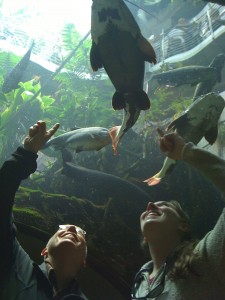National Science Teachers Association Conference by Lindsey Hansen, MSK Science Teacher
 This winter I was offered a chance to attend the annual National Science Teachers Association Conference in San Francisco. I knew this was an amazing opportunity, one that teachers with many more years of experience had never had the chance to enjoy, and here I was, a first-year teacher at Middle School of the Kennebunks, and I got to go! The Dick Beer Scholarship Fund for Science Staff Development funded my portion of the trip. The Education Foundation of the Kennebunks and Arundel paid the way for Mike Denniston, my science teaching partner at MSK. I was grateful for this, since after accepting the trip, I realized I had very little idea of what happens at a NSTA conference. Mike was a valuable asset. He gave me great advice on which sessions would be most worth my time and how to navigate the conference. It was also a wonderful opportunity for us to collaborate. In the evenings, we were able to discuss our curricula and use our knowledge from the conference sessions to create new lessons that we could bring back to our seventh graders. Mike and I decided we would get the most out of the trip if we chose different sessions to visit. That way we doubled the amount of information and ideas we could bring back to our students.
This winter I was offered a chance to attend the annual National Science Teachers Association Conference in San Francisco. I knew this was an amazing opportunity, one that teachers with many more years of experience had never had the chance to enjoy, and here I was, a first-year teacher at Middle School of the Kennebunks, and I got to go! The Dick Beer Scholarship Fund for Science Staff Development funded my portion of the trip. The Education Foundation of the Kennebunks and Arundel paid the way for Mike Denniston, my science teaching partner at MSK. I was grateful for this, since after accepting the trip, I realized I had very little idea of what happens at a NSTA conference. Mike was a valuable asset. He gave me great advice on which sessions would be most worth my time and how to navigate the conference. It was also a wonderful opportunity for us to collaborate. In the evenings, we were able to discuss our curricula and use our knowledge from the conference sessions to create new lessons that we could bring back to our seventh graders. Mike and I decided we would get the most out of the trip if we chose different sessions to visit. That way we doubled the amount of information and ideas we could bring back to our students.
As the weekend went by, I traveled to diverse sessions, and realized there were mainly two types available: workshops and speakers. At workshops, science teachers would gather at tables and get introduced to a potential lesson or a product for the classroom, or learn about an experience that was available to their students. For example, in “Integrated Hands-On Lessons for the Middle School,” the presenter gave us a booklet of short, hands-on physical science lessons we could use in our classroom that were also inexpensive and engaging. We then tried the activities and discussed possibilities for classroom use. I could easily see myself using the activities to engage my students in our astronomy unit. At another session titled “Teaching Energy Sources and Environment Together,” I got ideas for labs that I have since tried out in our current unit on energy. In one lab, students test the amount of energy used by a variety of appliances utilizing a tool called a Kill-A-Watt. This engaging lab integrated math and science by having students calculate watt usage over a year, as well as CO2 emissions, and calculate the potential cost to a homeowner.
In addition to workshops, I was able to visit a number of featured speakers including Bill Nye (the science guy) and Ira Flatow from NPR’s Science Friday. At the lectures, I heard information about cutting-edge scientific research, new ideas on how to incorporate technology in a classroom, and the latest brain research on the effects of technology and overstimulation on the teen brain. One of the most valuable speakers for me was titled “Tips for New Teachers.” At this session I was handed a CD of online and text resources as well as advice for lesson planning as a new teacher.
The trip to San Francisco was a huge success. On our flight back to Maine, Mike and I reflected on all we had learned on our trip out West. We agreed that the students at Middle School of the Kennebunks are fortunate to have so many dedicated teachers, administrators, and community members who support their education. During our trip, we often discussed our school and community with teachers from across the United States. We were constantly reminded that RSU 21 is at the top of its game, not only in Maine, but also in the entire country. Opportunities such as going to a national conference are what keep us competitive, and without the aid of EFKA, we wouldn’t be the schools we are today.